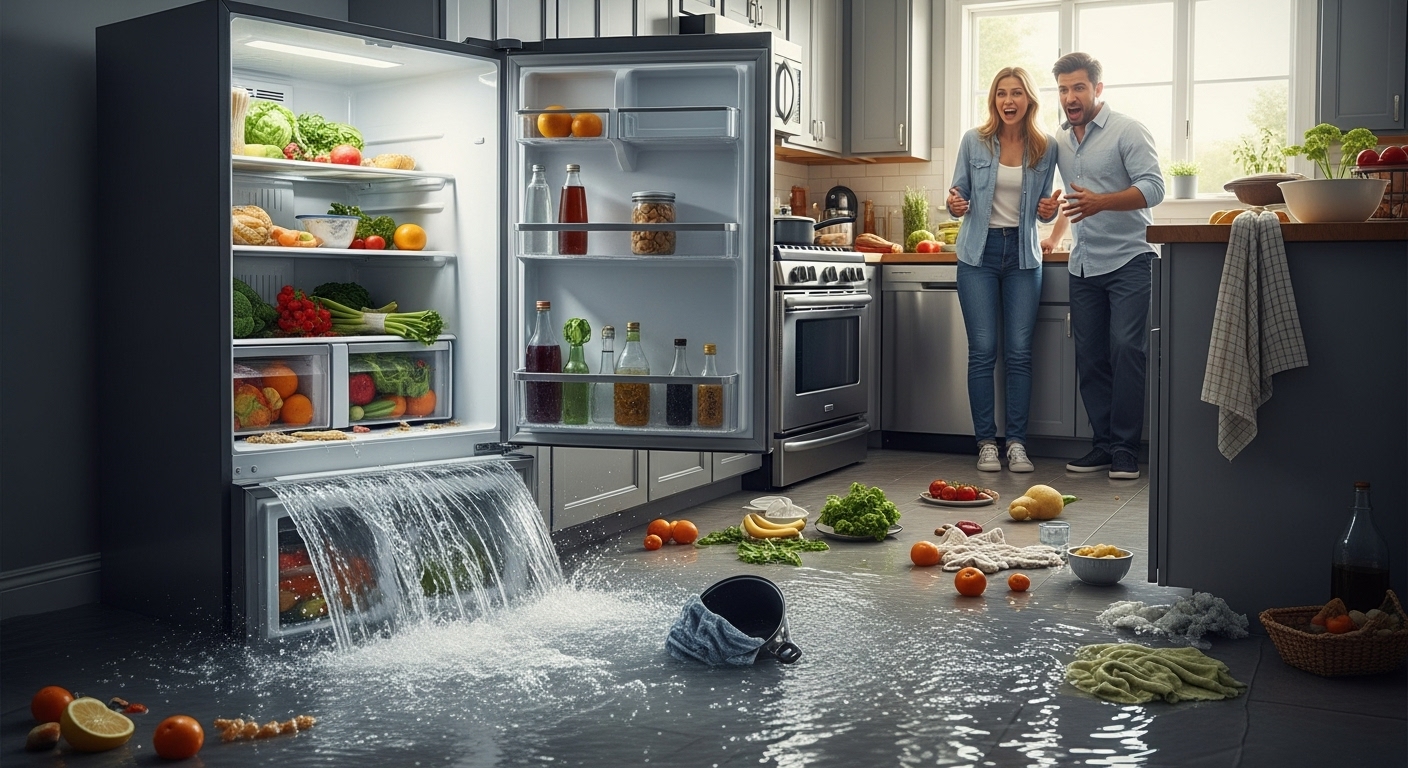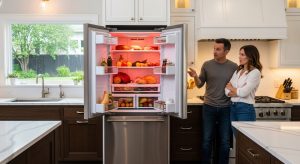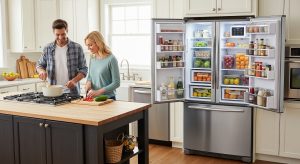Causes and Solutions
Discovering water pooling at the bottom of your refrigerator, dripping from shelves, or collecting under crisper drawers is both frustrating and concerning. Water inside your refrigerator can damage food, create slip hazards, promote mold growth, and signal underlying problems that could worsen over time. Understanding why water accumulates inside your refrigerator and how to fix it can save you from spoiled food, water damage, and costly repairs.
Understanding Normal Refrigerator Moisture
Before diagnosing a leak, it’s helpful to understand that some moisture in a refrigerator is normal. Every time you open the door, humid air enters and condenses on cold surfaces. Foods with high water content naturally release moisture. However, visible water pooling, dripping, or puddling always indicates a problem that needs attention.
Modern refrigerators are designed with drainage systems to handle normal condensation. When water accumulates visibly inside, it means either too much moisture is being produced or the drainage system isn’t working properly.
Most Common Causes and Solutions
Clogged Defrost Drain
The most frequent cause of water inside refrigerators is a clogged defrost drain. This small opening, typically located at the back of the refrigerator compartment near the bottom, allows water from the automatic defrost cycle to drain into a pan beneath the unit where it evaporates.
Over time, food particles, ice crystals, mold, and debris can block this drain hole. When blocked, defrost water has nowhere to go and pools at the bottom of the refrigerator or under the crisper drawers.
To locate the defrost drain, remove any shelves or drawers blocking your view of the back wall. Look for a small opening or groove at the bottom center or along the back wall. The exact location varies by manufacturer and model, but it’s usually obvious once you know what to look for.
To clear a clogged drain, first unplug your refrigerator for safety. Mix a solution of hot water with a small amount of baking soda. Using a turkey baster, pipe cleaner, or small funnel, flush the drain hole with this solution. You may need to work a pipe cleaner or flexible brush gently into the drain to break up stubborn clogs.
For persistent clogs, try using a mixture of hot water and a small amount of bleach to dissolve organic material and kill mold. Some people find that flushing with hot water alone works well. Continue flushing until water flows freely through the drain.
After clearing the blockage, pour several cups of water down the drain to ensure it’s flowing properly. Check the drain pan underneath the refrigerator to confirm water is reaching it. If water backs up again immediately, the problem may be deeper in the drain line or in the drain pan itself.
Frozen Defrost Drain
Sometimes the drain isn’t clogged with debris but instead frozen solid with ice. This is particularly common in refrigerators that run very cold or have defrost system issues. A frozen drain creates the same problem as a clogged one—water can’t drain and pools inside.
If you suspect a frozen drain, you’ll need to defrost it. The safest method is to unplug the refrigerator and allow it to defrost naturally with the doors open. Place towels around and inside the refrigerator to absorb melting water. This process can take several hours to overnight.
For a faster solution, use a turkey baster filled with hot water to melt ice in the drain. You can also carefully use a hair dryer on low heat to melt ice around the drain area, but never allow water and electricity to come into contact.
If the drain repeatedly freezes, this indicates a problem with the defrost system that may require professional attention. The defrost heater, thermostat, or timer might not be functioning properly, allowing excessive ice buildup.
Door Seal Problems
Damaged or dirty door gaskets allow warm, humid air to enter the refrigerator continuously. When this warm air contacts the cold interior, it condenses into water that drips down and pools at the bottom.
Inspect the rubber seals around all doors carefully. Look for cracks, tears, deformation, or areas where the seal has pulled away from the door. Run your hand around the closed door to feel for cold air escaping or warm air entering.
Clean the door seals thoroughly with warm, soapy water. Food residue, sticky spills, and dirt prevent proper sealing. Pay special attention to the folds and crevices where debris accumulates.
Perform the dollar bill test: close the door on a dollar bill so half is inside and half is outside. You should feel resistance when pulling it out. If it slides out easily, the seal isn’t adequate. Repeat this around the entire perimeter of each door.
If seals are damaged beyond cleaning, they need replacement. Replacement gaskets are available from appliance parts suppliers and are typically DIY-friendly, though some patience is required for proper installation.
Improper Refrigerator Leveling
A refrigerator that isn’t level can’t properly drain water to the defrost pan. If the front is lower than the back or the unit tilts to one side, water may pool instead of flowing to the drain.
Use a level placed on top of the refrigerator to check its position. The refrigerator should be level side-to-side and tilted very slightly backward (front slightly higher than back) to encourage water to flow toward the rear drain and to help doors close automatically.
Adjust the leveling legs at the front corners of the refrigerator by turning them clockwise to raise or counterclockwise to lower. Most refrigerators have adjustable front legs and fixed rear rollers. Make small adjustments and recheck with the level until properly positioned.
After leveling, pour water into the defrost drain to verify it flows freely to the drain pan. Proper leveling can immediately solve pooling water problems.
Damaged or Misaligned Drain Pan
The drain pan under the refrigerator collects water from the defrost drain. If this pan is cracked, overflowing, or positioned incorrectly, water may appear to be leaking inside when it’s actually the pan underneath that’s the problem.
Access the drain pan by removing the front grille at the bottom of the refrigerator. On some models, you’ll need to access it from the back. Carefully slide out the pan and inspect it for cracks or damage.
Empty the pan and clean it thoroughly with hot, soapy water. Check that it’s properly seated in its brackets or supports when you replace it. A pan that’s slightly misaligned won’t catch draining water properly.
If the pan is overflowing but not damaged, this suggests the water isn’t evaporating as quickly as it’s accumulating. Ensure the area under the refrigerator has adequate ventilation. The condenser coils should generate enough heat to evaporate water from the pan, but if coils are dirty, this process is less efficient.
Water Supply Line Issues
If your refrigerator has a water dispenser or ice maker, a leaking water supply line can cause water inside the unit. These leaks often appear as water in the fresh food compartment or freezer rather than just at the bottom.
Inspect the water line connections at the back of the refrigerator and where the line enters the unit. Look for obvious drips, moisture, or ice buildup around connections. Tighten any loose connections carefully—overtightening can crack plastic fittings.
Check the water line for cracks, kinks, or damage along its entire length. If the line runs through the freezer, ice buildup around it may indicate a leak. Water lines can become brittle over time, especially plastic ones, and may need replacement.
Inside the refrigerator, check the water filter housing for leaks. Sometimes filters aren’t properly seated or the housing develops cracks. Remove and reinstall the water filter, ensuring it’s fully locked into place. If leaking persists, the filter housing itself may be damaged.
Ice Maker Malfunctions
A malfunctioning ice maker can leak water into the freezer, which may then drip into the refrigerator compartment below. Common ice maker problems include overfilling that causes overflow, ice jamming that blocks proper drainage, or a fill tube that leaks.
Check the ice bin and ice maker area for excessive ice buildup, water, or frost. Remove the ice bin and inspect the ice maker mechanism for obvious problems. Look for water pooled in the bottom of the freezer or frozen to the freezer floor.
If water is overfilling the ice mold, the water inlet valve or fill mechanism may be faulty. Some ice makers have adjustable fill screws that control water level—consult your manual before adjusting these.
Ice buildup around the ice maker or fill tube often indicates that the fill tube is leaking. This tube delivers water to the ice maker and can crack or develop leaks at connections. Repairing or replacing the fill tube typically requires removing panels in the freezer and may be best handled by a professional.
Condensation from Temperature Issues
Excessive condensation can occur if the refrigerator is running too cold, if there are temperature fluctuations, or if the humidity control settings are incorrect. Some condensation is normal, but if you’re seeing large amounts of water, something is wrong.
Check your temperature settings. The refrigerator should be between 37°F and 40°F, and the freezer at 0°F. Running significantly colder than this causes excessive condensation as warm air entering the unit rapidly condenses.
If your refrigerator has humidity controls for crisper drawers, ensure they’re set appropriately for the foods stored there. High humidity settings are good for vegetables but can contribute to excess moisture.
Frequent or prolonged door openings introduce humid air that condenses inside. If you have children who stand with the door open or if you’ve recently added many warm items to the refrigerator, excessive condensation may be temporary.
Cracked or Damaged Water Reservoir
Some refrigerators with water dispensers have internal water reservoirs or tanks. If these crack or develop leaks, water appears inside the refrigerator without an obvious source.
This issue is more difficult to diagnose since the reservoir is typically behind interior panels. Signs include water appearing in unusual locations, water that doesn’t seem to be coming from the bottom or drain area, or leaks that persist despite fixing all obvious causes.
If you suspect a reservoir leak, professional diagnosis is recommended as accessing and replacing these components often requires disassembly of interior panels and knowledge of your specific model.
Blocked or Clogged Air Vents
While not directly causing leaks, blocked air vents can create temperature inconsistencies that lead to excessive condensation and frost buildup, which then melts and pools as water.
Check that air vents inside the refrigerator and freezer aren’t blocked by food items. Ensure nothing is preventing air circulation. When cold air can’t circulate properly, frost forms in unusual places and eventually melts into pooling water.
Diagnosing the Source of the Leak
To effectively fix water inside your refrigerator, you need to identify where it’s coming from. Empty the refrigerator of water and dry all surfaces thoroughly with towels. Place paper towels in areas where water typically accumulates.
Check back in a few hours to see where new water appears. Water at the bottom, especially under crisper drawers, typically indicates a drain problem. Water on shelves or running down walls suggests door seal issues or condensation problems. Water in the freezer points to ice maker or defrost issues.
Look at the pattern of water accumulation. Is it a small puddle or a large pool? Does it appear gradually or suddenly? Is it clear water or tinged with color? These details help identify the cause.
Prevention Strategies
Once you’ve fixed the leak, take steps to prevent recurrence. Clean the defrost drain every three to six months by flushing it with hot water. This simple maintenance prevents most drain clogs before they become problems.
Keep the refrigerator interior clean, as food particles are a primary cause of drain clogs. Wipe up spills promptly and clean under crisper drawers regularly where debris accumulates.
Inspect and clean door seals monthly. Check that doors close properly and create a tight seal. Ensure the refrigerator remains properly leveled, especially if you’ve moved it or adjusted its position.
If you have a water dispenser or ice maker, inspect connections and lines periodically for signs of wear or leaking. Replace plastic water lines with braided stainless steel lines for greater durability.
When to Call a Professional
Some water leak issues require professional expertise. If you’ve cleared the drain but water continues pooling, there may be a blockage deeper in the drain line that requires disassembly. If the defrost system isn’t working properly and the drain repeatedly freezes, you may need defrost component replacement.
Refrigerant leaks or sealed system issues sometimes manifest as unusual frost patterns and water accumulation. These require professional repair with specialized equipment. If you suspect the water reservoir, fill tube, or internal components are damaged, professional diagnosis and repair are recommended.
Any situation involving electrical components and water should be handled carefully. If you’re uncomfortable performing repairs or if simple solutions haven’t resolved the problem, professional service is the safer choice.
Temporary Measures While Awaiting Repair
If you’re waiting for parts or professional service, you can manage the water temporarily. Place towels at the bottom of the refrigerator to absorb water—change them daily to prevent mold and odors. Keep a shallow pan or tray under crisper drawers to catch pooling water.
Reduce the amount of humid air entering by minimizing door openings and ensuring doors close completely. Avoid storing very warm items that increase condensation. Check and empty your temporary water collection methods daily.
The Bottom Line
Water leaking inside your refrigerator is usually caused by simple, fixable problems—most commonly a clogged or frozen defrost drain. By systematically checking the drain, door seals, leveling, and other potential causes, you can often identify and resolve the issue yourself without professional help.
Regular maintenance, particularly keeping the defrost drain clear and door seals clean, prevents most interior water leak problems. When you catch and fix these issues promptly, you protect your food, prevent mold growth, and avoid more serious damage to your refrigerator and kitchen floor.
Don’t ignore water inside your refrigerator. What starts as a minor puddle can become a breeding ground for mold, damage food stored in drawers, and eventually affect your refrigerator’s efficiency and lifespan. Address the problem promptly, and your refrigerator will continue serving you reliably for years to come.



